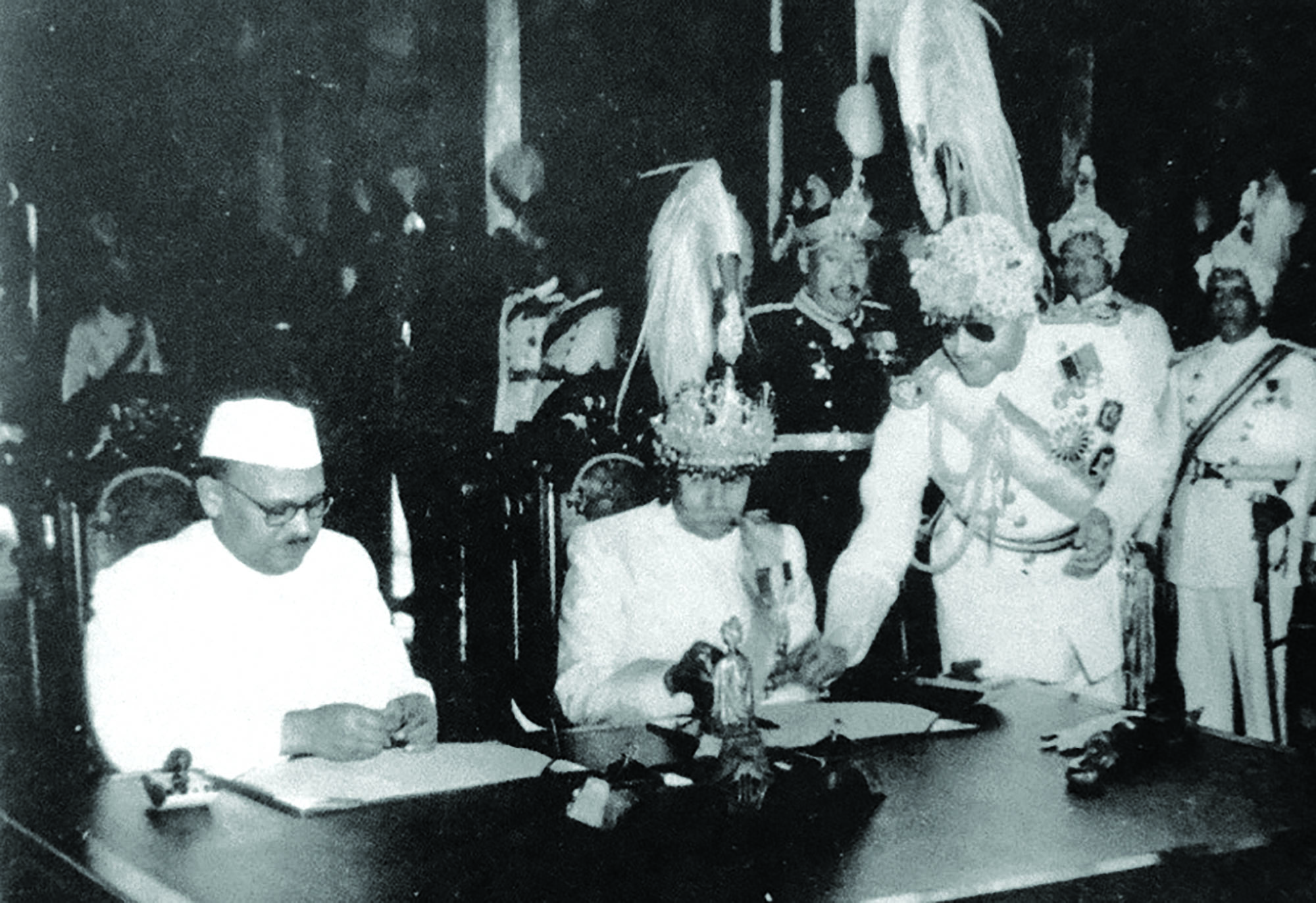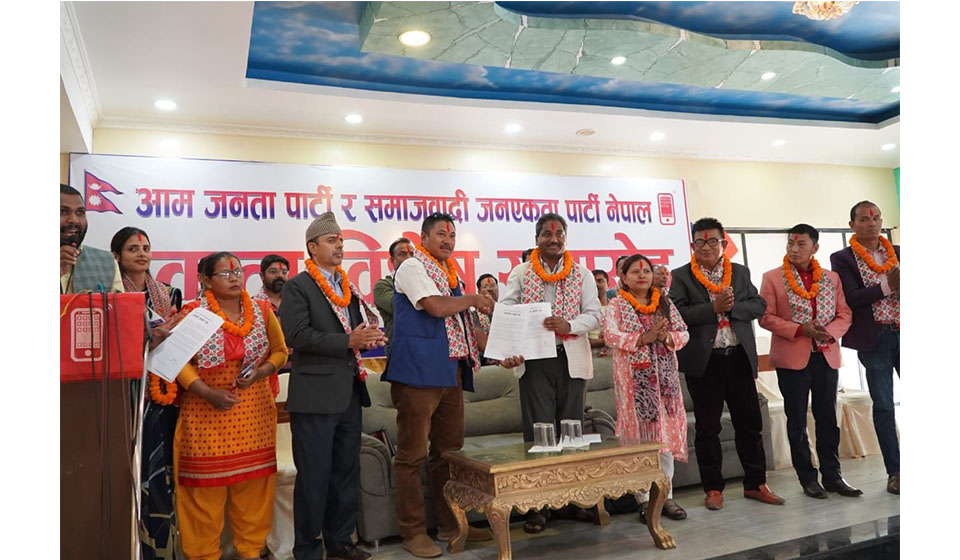
OR
Opinion
Nepal-Britain Treaty: The Centennial
Published On: December 31, 2023 08:05 AM NPT By: Nandan Prasad Adhikari

More from Author
The Nepal-Britain Treaty was nationally celebrated with festivities while the Nepal-India Treaty continues to be disputed.
The year 2023 marks the centenary of the Nepal-Britain Peace and Friendship Treaty that had formally recognized the sovereignty and independence of Nepal in black and white. Since 1923, the world has witnessed profound political changes but the special friendship between the two countries remains intact as they mark a hundred years of old diplomatic history of mutual esteem, respect and cooperation.
In his coronation ceremony speech, the last Rana Prime Minister, Mohan Shumsher (1885-1967) had vouched for "having a cordial relationship” with India, and also mentioned the signing of the 1923 Treaty with Great Britain. He also talked about the exchange of envoys with the United States of America in 1947 and efforts of keeping harmonious relations with China, France, the Netherlands and Belgium. Nevertheless, Nepal was forced to sign a separate treaty with Independent India within 24 years of signing the Nepal-Britain Treaty.
The 'Nepal-Britain Peace and Friendship Treaty 1923' is the pillar on which the 'Nepal-India Peace and Friendship Treaty 1950' stands. Though the Nepal-India Treaty has replaced the Nepal-Britain Treaty, the latter is yet considered an instrumental tool for necessary diplomatic citations. Prithvi Narayan Shah's unification campaign of turning independent Nepal as one single sovereign entity had led it ultimately to the Nepal-Britain Treaty. In manifesting the glorious history of Nepal and the United Kingdom, evidential proof of the historic document of 'undivided, sovereign and independent nation' lies as the legal basis of the Nepal-Britain Treaty. Not surprisingly, all counties of the world including neighbouring India and China have appreciated the sovereign status of Nepal as an independent nation.
A treaty signed by any independent nation is viewed as a continuous process of national existence. As the Nepal-India Treaty sticks upon the Nepal-Britain Treaty, it was just as appropriate to recognize Nepal as an 'independent and sovereign nation' and dismiss, among others, Nepal's earlier treaties, agreements, articles, documents and engagements. The section 2 of the Nepal-India Treaty rejects Nepal's past treaties of December 21, 1923 with British Government, March 24, 1856 treaty with Tibet (Thapathali Treaty), December 2, 1815 treaty with the East-India Company Government (Sugauli Treaty) and October 2, 1792 treaty with Tibet-China (Betrawati Treaty) and June 2, 1789 treaty with Tibet (Kerung Treaty).
In view of the existing geo-political mess and the wake of democracy, the Nepal-India Treaty was signed by Prime Minister Mohan Shumsher with glimpses of the Nepal-Britain Treaty. Among others, though seven sections of both treaties look similar in nature, the introduction of the Nepal-India Treaty plus other disputed articles have led to controversies including persistent demands for timely replacement of unequal sections, especially in the changing context of the fast changing world. For settling such disputes, the Eminent Persons' Group was quickly established by both countries to review various aspects of Nepal-India ties including timely amendment of the Nepal-India Treaty but the unanimous report that was finalised in July, 2018 continues to gather dust in the absence of due attention.
The Nepal-Britain Treaty was nationally celebrated with festivities while the Nepal-India Treaty continues to be disputed. The Treaty of Sugauli and the Nepal-India Treaty were made under pressures of British-India and Independent-India, respectively. But the Nepal-Britain Treaty had not faced any pressures and/or influences from India, China and Britain, which was solely achieved by valour and efforts of decades' long Nepal's own diplomatic pursuits.
The Nepal-Britain Treaty was initiated in course of Nepal's valour and courage of Nepalis and its credit largely goes to Prime Minister Chandra Shumsher (1901-1929). Chandra Shumsher's single minded pursuit for recognition of Nepal as a sovereign and independent nation is to be credited for the signing of the Treaty with England in 1923. Nepal's international image was atop under the rule of Chandra Shumsher despite contradictions in national politics. By diplomatically confirming Nepal as a sovereign and independent nation in the world map, Chandra Shumsher had secured a concomitant title of 'His Majesty' to the King, established the Gurkha Recruitment Center for Nepal Army to be used as soldiers to serve the British Emperor and appointment of ambassadors, instead of British Resident in Kathmandu and London.
Chandra Shumsher was a brilliant and avowed reader of English newspapers ever since his student days in Kolkata leading to his matriculation in the English medium. At that time, newspapers published from Britain took almost a month to reach Kolkata by ships from London via the Cape of Good Hope of Africa. In contrast, the English newspapers started to reach Kolkata within a week after the opening of the Suez Canal in Egypt. Serious reading of newspapers helped Chandra Shumsher to trace the strength and weaknesses of the English Empire, not to mention the ways to deal with Englishmen.
Muluki Ain, a legal code of governance, was chartered by Political Statesman Junga Bahadur Rana (1846-1877) after acquiring Naya Muluk lost by the Treaty of Sugauli signed during Bhimsen Thapa's Prime Ministership earlier. The Naya Muluk comprises four districts namely Banke, Bardia, Kailali and Kanchanpur. Prime Minister Junga Bahadur had also been successful to acquire close attention of no less a person than Britain's Queen Victoria herself during his earlier sojourn to England, not to mention close rapport with Lord Curzon, later the Viceroy of India. But a hardcore nationalist Chandra Shumsher worked hard to realise the same by the means of a legal treaty.
In the process of consolidation, when much of South Asia but for Afghanistan was under British subjugation, the deepest threat to safeguarding sovereignty and independence was the main national concern. An ambitious ruler, Chandra Shumsher's aim was to acquire recognition of Nepal's national and sovereign existence by means of a treaty with the British. By having keenly observed national degradation and inequitable status of Nepal following the Treaty of Sugauli, Chandra Shumsher's one single agenda was to secure Nepal's sovereign independence from the British Government in legal terms.
Chandra Shumsher's official visit to India in 1903 was no less interesting. He had initially sent words of not accepting Delhi's invitation if Nepal was not kept on par with the King of Kashmir and Nawab of Hyderabad at Delhi Palace. As the invitation had to be accepted for geo-political compulsions under British rule, he moved diplomatically. Meanwhile the legendary ruler focused himself in making a separate identity of Nepal at the Delhi Palace.
Lord Curzon (1899-1905), a royal notable of high promise had been invited early on for hunting expeditions in Nepal and Chandra Shumsher had worked hard for establishing a close rapport. After being informed of Nepal's ranking at third in protocol, he focused himself on making a diplomatic impression of a different kind. The allotted ten minutes for an audience with Curzon got extended by over an hour once Chandra Shumsher raised the issue of ongoing Russian overtures to Nepal, now that they had already been successful in sending a mission to Lhasa.
Chandra Shumsher's initial entry at the Delhi palace was equally dramatic. Riding a 16-horse carriage and carrying horsewhip, Chandra Shumsher had amazingly reached the invitation site of the Viceroy's residence at Delhi's Rajpath. All, no less the guests were surprised to see Chandra Shumsher seated on par with the King of Kashmir and Nawab of Hyderabad. In 1904, Chandra Shumsher was duly thanked by Great Britain for directly helping to send a special military mission to Tibet under Sir Francis Edberg Young Husband, historically called the 'Young Husband Mission.'
In 1908, Chandra Shumsher visited Britain and received a 19-cannon salute along with high state honours as an envoy of the King of Nepal. At that time, the newly appointed Viceroy was Lord Minto (1905-1910). Chandra Shumsher succeeded in making a distinct impression on the Brits as he had himself adopted English ways and working styles. He was awarded an honorary 'Doctor of Civil Law' at the University of Oxford. The UK Herald Tribune had also published the news item of Chandra Shumsher's donation of five hundred pounds to the poor of Edinburg during his stay of some eleven weeks in England. At the same time, Chandra Shumsher also visited France and acquainted himself with the famous French legal system, the 'Napoleon Code.' Almost 57 years after Junga Bahadur's Europe visit, Chandra Shumsher also used the same route and was said to have climbed the Eiffel Tower two days after he reached Paris.
In 1911, during a hunting expedition of King Gorge (V) of Britain in the Tarai region of southern Nepal, Chandra Shumsher requested him to recognize Nepal as an independent country. Chandra Shumsher was also to assist the British Emperor with an offer of a 20-battalion of the Gurkha Recruitment Center during the First World-War (1914-18). With Nepali soldiers reaching almost 250,000, a royalty to Nepal was doubled from one to two million Indian rupees, which was being collected through the State Bank of Bengal. Chandra Shumsher had not only issued commercials to increase the number of military for the British Emperor but also deposited around 14.1 million Indian rupees including tangible substances in the war fund, which was highly praised by the Governor General by sending a letter of influence for Nepal's assistance and artistry of Nepali soldiers. When the number of Nepali soldiers in the British Army continuously increased, a separate brigade was established, the 'Brigade of Gurkha.
Nepal's contribution was matchless to the Allies in the First World-War. Almost 24,000 Gurkha casualties in Gallipoli of Turkey, trenches of Belgium and France were reported, the heavy price of Nepali blood was to be rewarded sooner rather than later. With the English Allies victorious in 1918, the valor of Gurkha and goodwill of Nepal was much to be appreciated. In spite of letters written among others by the German Imperial Chancellor during the First World-War inciting Nepal against the British Emperor, Nepal remained intact with Britain and Britain outrightly rejected wrong information. Such military assistance to the Brits was viewed by some to save powers, while others saw it in a way to the Treaty of 1923. Not surprisingly, the organiser of frightening experiences, Germany's last King Kaiser Wilhelm II said at the time of the Great-War, "I'll not be afraid to counter my dearest army against any military in the world, but my heart trembles as soon as being said Gurkha Army."
In 1921, Britain's Prince of Wales (King Edward VIII) came for a hunting expedition in the Chitwan region at the invitation of Chandra Shumsher. A high-level Russian delegation had earlier visited Tibet. Chandra Shumsher had quietly informed the Brits about the Russian overture. As Britain had a bitter relation with Russia at that juncture, Chandra Shumsher had masterfully conveyed to Britain about the treaty's benefits by highlighting geo-political tensions Nepal had to face in danger of the Russians entering British-India via Nepal. For removing confusions in Edberg's mind about the Russians and payment for Nepal's assistance, Great Britain appears to have ultimately reached a conclusion in having a treaty with Nepal as a part and parcel of the package designed to reward Nepal for its help in the First World-War. Also, the British Government had no other option left than to honour the Barcelona Convention of 1921, which provided transit freedom for land-locked countries. Ultimately, Chandra Shumsher's tactful endeavours paid dividends in the form of the Treaty of 1923. And, London finally sent a draft proposal of the treaty to Kathmandu.
When the draft proposal arrived, Chandra Shumsher had ordered Yagnamani Acharya Dixit to study the draft. As Yagnamani was the first Nepali conferred with a master's degree in political science from Presidency College, Kolkata University in 1921, he had changed one paragraph of the draft of the proposed treaty for adhering to sovereignty and independence of Nepal and when he was later on kept as an advisor to the connoisseur ruler, his eyes and hands specially moved towards English letters and documents of the Munsikhana, the then Foreign Affairs Department. Marichiman Singh Pradhan, chief of Munsikhana and Yagnamani had taken more than two years in corresponding letters and visiting Kolkata for modifying particularly sections 3 and 7 of the draft proposal. Such correspondences are known as a big achievement in the views of foreign policy makers. Chandra Shumsher had successfully concluded the amended provisions of the treaty through wise cultivation of enriched relations with Britain. The final draft was typed by another stalwart Narendramani Acharya Dixit, the first official foreign secretary of Nepal (1948-1953).
London finally accepted Nepal's modified version of the draft of the proposed treaty, resulting in a signing ceremony organised in style at the Gallery Hall of Singha Durbar, Kathmandu. By hosting toasts with full military honours and 31-gun salutes, the treaty of peace and friendship between Nepal and Britain was signed on 21st December, 1923 by Chandra Shumsher and the British Resident, Sir Lieutenant-Colonel William Fredrick O'Connor. Both delivered their speeches in English, which were translated by Marichiman in Nepali. At once, Great Britain had recognized Nepal as a "unified, sovereign and independent nation."
"A magnificent dome crowning the whole '' was vouched by Chandra Shumsher on the occasion. High level celebrations were made by illuminated lightning throughout the capital, authorising a 2-day national holiday, pardon of 3-month sentences to prisoners and, permitting a 2-day gambling at Kathmandu and Patan. The news was published in the Gorkhapatra on December 24, 1923.
The Nepal-Britain Treaty ensured the establishment of friendly ties, guarantee sovereignty, reaffirm the Treaty of Sugauli, inform problems and disallow the use of the territory against each other, address security guarantee, open for importing weapons and remove customs duty and/or tariff barriers for bilateral trade of imports and exports.
On August 7, 1925, when the Nepal-Britain Treaty was kept in records at the League of Nations, Nepal was no longer a new country to the world community. Consequently, Nepal could not be merged in India immediately after its independence in 1947 like other soft Indian states like Hyderabad, Gwalior, Baroda and Junagadh.
Chandra Shumsher's life story was written by Rammani Acharya Dixit in Nepali, translated in English by TN Roy of Kolkata and corrected by Yagnamani and Chandra Shumsher's son Keshar Shumsher, which was first published in 1905, formally translated in English in 1910 from Sylvain Levi's French edition and officially published in two volumes from England in 1928 under the title, 'NEPAL' by Perceval Landon. The book had not only boosted Nepal's glory in the international arena but also highlighted the everlasting relations between England and Nepal. The book was also later on submitted in the process of applying Nepal's membership to the United Nations.
Sati, a late practice in which a widow sacrifices herself by sitting atop her deceased husband's funeral pyre, which absolutely diminished the rights of women, was not yet ended. Queen Victoria was said to be shocked after hearing news of three queens going as Sati along with Janga Bahadur's dead body, the abolition of wrong tradition was necessarily to be scrapped sooner rather than later. Chandra Shumsher had finally abolished the Sati tradition on July 8, 1920, which was also an attempt to please the British Emperor in the course of making the Treaty of 1923.
As the League of Nations had already praised Chandra Shumsher for redemption of slavery in Nepal earlier than Europe in November, 1924, signing of the Nepal-Britain Treaty got diplomatic benefits as well. After publishing Chandra Shumsher's works in the European newspapers, it was reported that some American universities wanted to award him as well. For making Nepal's interest alike England's at the end of Chandra Shumsher's rule, a pioneer report was presented before him, which was a step forward in making a constitution that properly suits to Nepal after studying constitutions of America, England and Japan by experts duo in English and French, Deepakraj Tuladhar and Yagnamani respectively.
As Chandra Shumsher had enormously contributed to legally making Nepal recognized as an independent and sovereign nation, he must be added in the list of 'national personality' on the occasion of a centenary of the Nepal-British Treaty. Though basic needs of the Nepalis were not fulfilled under the autocratic Rana rule of over a hundred years, the Ranas did not ever lose in promoting Nepal's national interests especially in foreign policies.
In 1934, with the establishment of the Royal Nepal Embassy, Nepal became the first South Asian country to appoint its ambassador in London's prime location, 12A Kensington Palace Gardens. Nepal's first Ambassador to the UK was Bahadur Shumsher JB Rana (1934-1936).
Bijaya Shumsher JB Rana, director general, Foreign Affairs Department, had formally communicated Nepal's membership at the United Nations through letters of February 13 and March 10, 1949, which was rejected from the veto used by Soviet Union Russia-Ukraine. Although Nepal had bilateral relations with neighbouring China and India since 1792 and 1947 respectively, Nepal was asked to prove its independence and sovereignty. Nepal had submitted evidence of the Treaty of 1923, which had explicitly affirmed sovereign and independent status stating "the Government of Nepal has never considered that either the Sugauli Treaty and/or any other treaties, agreements or engagements impaired its independence and sovereignty." On behalf of the Nepal-Britain Treaty, Nepal's application of membership was unanimously confirmed by the General Assembly of the United Nations on December 14, 1955.
Time has witnessed many royalties from London to Kathmandu and vice-versa. King Mahendra and Queen Ratna in October 18, 1960, King Birendra and Queen Aishwarya in November 18, 1980, Queen Elizabeth II and Prince Philip in March 1961 and February 17, 1986, the Duke of Edinburg, Princes Diana, King Charles III and other high dignitaries had paid their state and official visits. Prince Harry had famously served alongside the 1st Battalion of the Royal Gurkha Rifles during his tour of Afghanistan in 2007-08, which was an honour to both Nepal and the UK. Time and again, Nepal's head of the government and people of both countries had also made multiple wonderful trips in both counties.
It is recorded that around 47,902 Gurkha soldiers were killed, wounded and/or went missing as on August 15, 1947 in the first and second World Wars. The Gurkha soldiers had not only fought bravely with communist guerilla warfare in Malaysia but also won the war of the Falklands island against Argentina. As the valour of Gurkha is unmatchable till date, the Nepalese Army is presently contributing as the second largest troops in some twelve worldwide missions for peace and stability under the United Nations.
As the breadth of people to people connections touch on all segments of society, the Department for International Development (DFID-Nepal) is performing activities on behalf of the British Embassy in promoting education, health, economic developments, militaries, human rights and society. The Britain-Nepal Society, Britain-Nepal Medical Trust and Nepal-Britain Chamber of Commerce and Industry are also active to promote goodwill of both countries. Though Nepal and the UK had also signed an Investment Promotion and Protection Agreement on March 2, 1993, Nepal has not been able to get benefits in export of quality goods even if there exists provision of zero tariff interest rate for certain goods. The irony is that Nepal is continuously facing a financial loss with the UK and could not achieve a business of one billion rupees in the last fiscal year.
In short, Nepal has also lost its due respect and dignity that Nepalis had once rightfully earned and maintained in the international arena. Nepal's foreign policy is always degraded and disturbed nationally as well as globally. The ability of Nepalis to conduct diplomacy has been fragile and has eroded over the years. The recent election of the World Health Organization Regional Director for the South-East Asia Region is the latest evidence. Similarly, Nepali's image is also vanishing as many Nepalis are now fighting as soldiers in the ongoing war between Russia and Ukraine on their own.
Presently, Nepal is one of the poorest countries in Asia, which has dangerously affected Nepal's economy. Among others, political instability, bad governance, corruption, unemployment and inflation have been the major reasons that have forced many Nepalis to leave the country.
Finally, for re-establishing Nepal's lost status, policy of non-alignment, neutrality and equilibrium between countries of diplomatic orders through the theory of Panchsheel must be cautiously readdressed. From possible geo-political danger to protect Nepal's independent and sovereign existence, statesmen like Chandra Shumsher are the need of the hour. For establishing Nepal's deep friendship with the UK, the Nepal-British Treaty deserves national tributes in postage stamps and minted coins. As Nepal has yet to learn many diplomatic lessons from the UK, there must be a perpetual friendship between Nepal and the UK where both must look forward to the next century of togetherness.
You May Like This

NATO Serving as a Catalyst to Fuel Violence
The North Atlantic Treaty Organization, or NATO, celebrated its 75th anniversary on April 4, 2024, reaffirming its commitment to stand... Read More...

Navigating the Digital Diplomacy Divide: Balancing Tradition and Technology in Global Relations
In an era marked by changing world order, climate change, a weak global economy, escalating conflicts, and profound human suffering,... Read More...

Evidence-Based Policy Making in Nepal: Challenges and the Way Forward
“Life and health can never be exchanged for other benefits within the society.” With this vision, the Swedish Parliament in... Read More...


Just In
- Sunkoshi-Marin Diversion Project’s tunnel construction nears completion, breakthrough scheduled for May 8
- Govt tightens security arrangement for Third Investment Summit 2024
- Pesticide residue found in vegetables in Nepalgunj
- Aam Janata Party and Samajwadi Jana Ekata Party merge
- 1,600 participants confirmed for Nepal Investment Summit
- Ilam-2 by-elections held peacefully, vote count likely to start tonight
- NEA schedules five-day power cut across Kathmandu Valley for underground cable installation
- Hundreds of passengers including foreign tourists in distress as poor visibility halts flights to and from PRIA








-1200x560-wm_20240427144118.jpg)






Leave A Comment